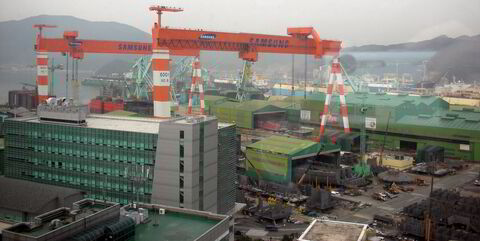Compliance with emissions regulations could cut the supply of bulkers to the market by up to 2% per annum over the next two years, which will help offset net fleet growth as demand falls too, according to Clarksons Research.
The research arm of the world’s largest shipbroker said that slower sailing speeds and the time taken to retrofit energy-saving technology on board vessels would absorb tonnage from the trading fleet as shipowners take steps to comply with environmental regulations like the Energy Efficiency Existing Ship Index and Carbon Intensity Indicator.
This will provide some support to bulker markets in the face of an expected slowdown in bulker demand growth, according to Clarksons, which outlined a “moderate” outlook for 2024.
“Current projections suggest bulker demand growth may fall just below fleet growth (both [circa] 2%), despite a limited delivery schedule and potential for increased demolition,” the firm said in its Dry Bulk Trade Outlook for October, published on Thursday.
“A range of other factors have potential to support market trends, including vessel speeds and increased [energy-saving technology] retrofit time as environmental regulations impact.
“However, uncertainty remains on the demand side, including risks around the global macroeconomic backdrop, whilst there is also uncertainty around Chinese dry bulk demand given ongoing challenges in the property sector and sensitivity to government coal policy.”
A more significant turnaround for bulker markets could come in 2025, if global macroeconomic conditions improve broadly. In such a scenario, Clarksons thinks the dry bulk trade will grow by 1.5% in tonnes or by around 2% in terms of tonne-miles, while fleet growth remains below 1%.
“However, the ambition and implementation of ‘green’ policies in key economies is likely to become a key underlying factor in demand for some dry bulk cargoes (e.g. coal) going forwards,” the firm noted in its report.
The global bulker fleet’s average speed this year to date is down by 1.7%, compared to the same period last year on the back of softer markets. It averaged 10.9 knots during September.
Port congestion this year to date has averaged 30.5% of the live fleet in terms of deadweight tonnage, down by just over 2% compared to the same period in 2022. Around 28.9% of bulker tonnage was tied up by congestion last month.
The tonne-mile trade is expected to grow by 4.6% this year but net fleet growth, congestion and slower sailing have boosted the trading fleet’s active capacity this year. Clarksons said this means demand growth in 2023 will be just 3% above the 2021 level in terms of tonne-miles, while bulker fleet capacity will have grown by 6% over the same period.
The firm expects the tonne-mile trade to grow by 1.8% next year and by 1.6% the year after.
Going forward, the low orderbook will continue to be supportive. The global bulker orderbook remains at a near 30-year low of less than 8% of fleet capacity.
Clarksons expects overall bulker fleet growth to remain steady at 2.9% in 2023, before slowing to 2.2% next year and 0.9% in 2025.




